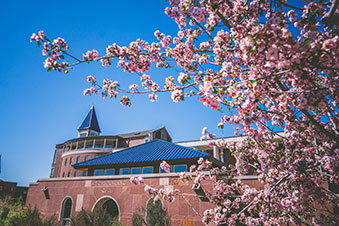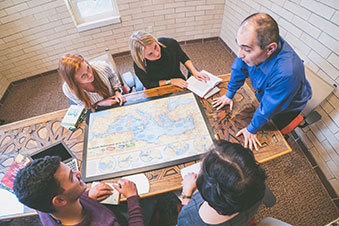DU Grad’s Research Finds Microplastics in Colorado Waterways

At the University of Denver, Lexi Kilbane didn’t study science in the traditional sense—she didn’t wear a white lab coat or conduct experiments. She received a master’s degree in international human rights from the Korbel School of International Studies, graduating this past spring.
But thanks to a post-grad internship with the nonprofit organization Environment Colorado, Kilbane found herself knee-deep in a scientific study, examining water samples for microplastics—microscope and all. Earlier this year, Kilbane co-authored a report on the study, “Colorado’s Waterways and Microplastics: A Survey of Rivers and Streams Along Front Range Watersheds in Colorado.”
Working with local high school students and the research group CoPIRG, Kilbane’s team found microplastics in all of the 16 bodies of water from which her team took samples.
Kilbane says that even though microplastics research wasn’t what she thought she’d be doing after graduation, the problem hit home for her.
“When I got into the background research and realized that this is a very pervasive issue, then the salience [of it] started emerging, because the microplastics embed themselves in so many different ecosystems, especially ones that have water,” Kilbane says.
The project examined water samples for four different types of microplastics: fibers (from clothing and textiles); film (from plastic bags and flexible packaging); fragments (from harder plastics); and beads (from facial scrubs and cosmetic products).
The team found plastic microfibers in 100% of the samples they tested. Microplastics can be harmful to both animals and humans; a recent study published in the Yonsei Medical Journal found that when absorbed into the body, microplastics can cause diseases in the endocrine and reproductive systems.
Kilbane says getting into the minutia of the research fascinated her.
“As someone without a science background, it was astounding to me that I could uncover this issue through using rudimentary scientific materials and experimentation,” she says. “But as a citizen scientist, I was able to go into these ecosystems and literally see the issue before my eyes through a microscope.”
One of the project’s goals was to spread awareness about the microplastics problem ahead of Colorado’s full ban on the business use of plastic bags and Styrofoam cups and containers in January 2024.
“We didn't want individuals in Colorado to think that this was random government overreach that wasn't really serving a purpose,” Kilbane says.
Kilbane’s team also made recommendations in the report, including pleas to phase out single-use plastics and reduce “fast fashion” clothing production. She says that even though the microplastics problem will require a large-scale solution, there are things that people can do to reduce their individual plastic use.
“As consumers, we can reduce the demand for these plastic products and put less of them into the environment, even if we think we're disposing of them in a proper way,” Kilbane says. “And we've discovered that [microplastics are] getting into areas that aren't just for refuse and garbage. The crux of the issue is that we need to have less plastic.”
Though Kilbane’s time at DU wasn’t spent in a lab, she says her education in the social sciences did help prepare her for the time she’s spending in the science world.
“I definitely think my engagement with all different types of sciences helped prepare me to improve the rigor of the study and make sure we came up with results that we could really stand behind and be confident in,” she says. “DU, of course, helped me improve my writing in terms of research and presentation, which is invaluable in spaces like that.”
While Kilbane hasn’t settled on what she’ll do next, she knows that her experience working on the report has helped inform her career path.
“I am looking to pursue a career at the intersection of human rights and environmental justice and climate justice,” she says. “I'm really hoping to do impactful work with a nongovernmental organization that's doing evidence-based and community-led projects.”


